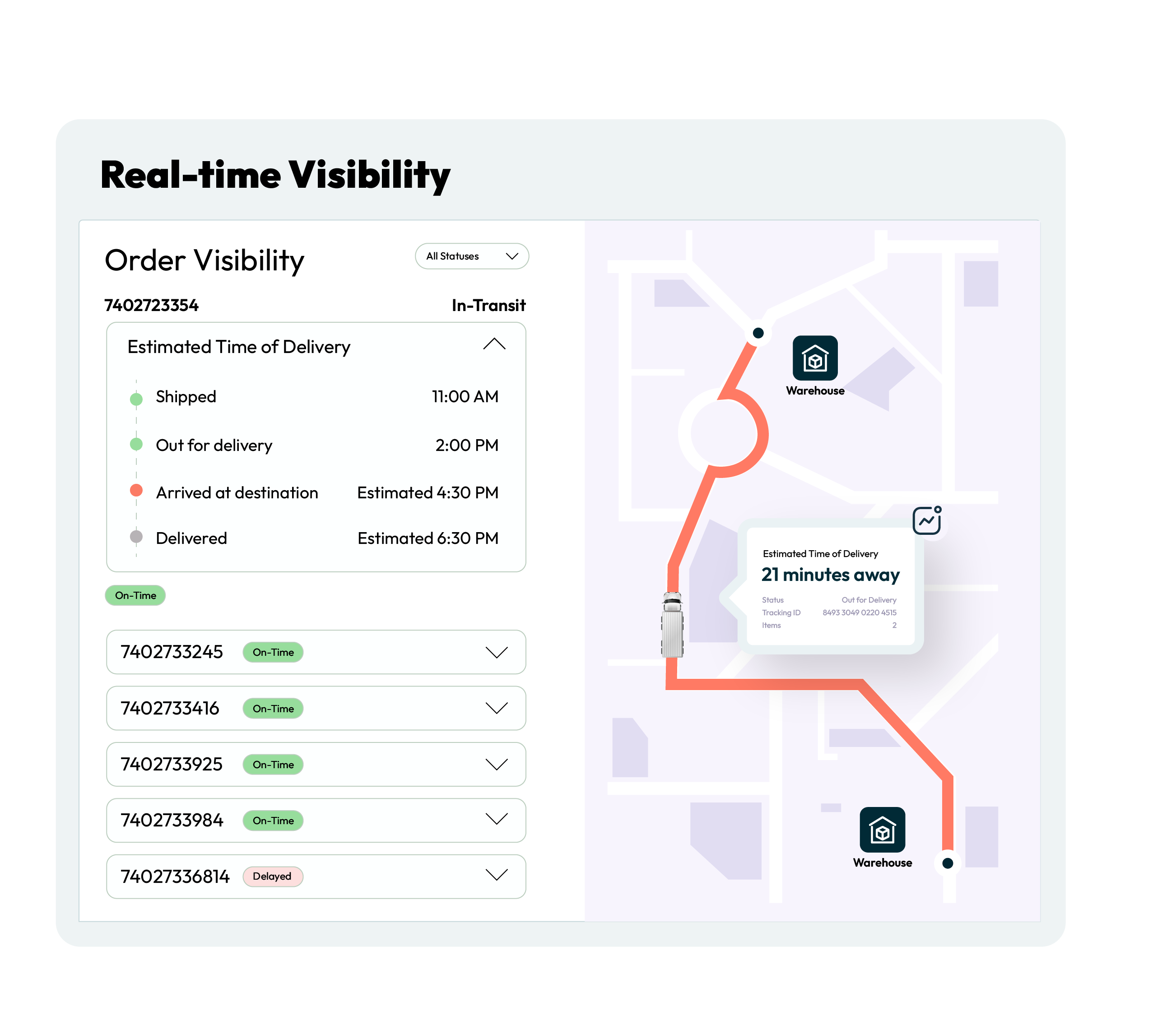- Truck Routing
Fighting Detours and Delays: Tactics to Improve Operational Efficiency Using Truck Routing Software
Table of Contents
- Understanding Detours and Delays in Truck Routing
- The Customer’s Perspective: What is at Stake?
- Rethinking Routing: Why Traditional Approaches Fall Short
- How Modern Truck Routing Software Transforms Operations
- Tactics to Combat Detours and Delays with Truck Route Software
- Beyond the Route: Broader Gains from Smarter Truck Route Software
- Measuring Success with Control-tower KPIs
- Key Features to Look for in Truck Routing Software
- Turning Disruption into Opportunity

Every logistics operation has a common goal: deliver on time, every time. Yet, without the right truck routing software, detours, traffic delays, and missed delivery windows often stand in the way. For most US businesses that rely on trucking, these challenges directly affect profit margins and customer satisfaction.
Whether you’re running a regional distribution hub or managing daily replenishment for retail stores, you’ve felt the strain of traffic detours, roadwork, and missed delivery windows. These aren’t just operational headaches; they directly impact profit margins and customer satisfaction.
The scale of this challenge is hard to ignore. The American Transportation Research Institute reported that congestion and unexpected delays cost US fleets over $108.8 billion annually. This figure reflects not only wasted miles and fuel but also lost trust when orders don’t arrive on time. The stakes are high, and finding effective solutions is now a matter of business survival.

Understanding Detours and Delays in Truck Routing
Before seeking solutions, it’s critical to examine why detours and delays occur so frequently. Today’s truck routes must contend with far more than just distance; they’re influenced by regulatory constraints, unpredictable weather, strict delivery windows, and ever-changing traffic patterns.
A single closure on a key highway or a last-minute roadwork notice can set off a chain reaction. Delivery teams are forced to reroute, risking missed time slots and expensive penalties. When these situations happen daily, the cumulative impact erodes both efficiency and customer loyalty.
The Customer’s Perspective: What is at Stake?
For shippers and receivers alike, reliability is non-negotiable. Imagine a scenario where a popular grocery chain promises morning restocks for key locations. A single delayed truck, held up by unplanned detours, means empty shelves, disappointed customers, and potential revenue loss for the retailer.
On the other end, a distribution center must adjust shift schedules, reallocate resources, and often pay overtime to meet service level agreements (SLAs) after a delay. This operational disruption is not unique; it’s a shared pain point across retail, manufacturing, healthcare, and every industry that depends on time-sensitive deliveries.
Rethinking Routing: Why Traditional Approaches Fall Short
Many organizations still depend on manual routing, basic GPS navigation, or outdated TMS tools. These systems rarely factor in real-time variables like live traffic, road restrictions, or driver compliance. As a result, they create routes that look good on paper but quickly unravel when conditions shift.
Manual intervention is often needed to handle exceptions, which increases dispatcher workload and heightens the risk of errors. More importantly, it limits the scalability of growing fleets, and more complex delivery networks only amplify the problem.
How Modern Truck Routing Software Transforms Operations
Truck routing software has fundamentally changed the way fleets operate. The latest generation of platforms leverages artificial intelligence and machine learning to process real-time data, predict disruptions, and optimize routes on the fly.
FarEye, for example, brings together AI-based routing, deep integration with live traffic feeds, and multi-constraint optimization. The result is not just faster planning but truly resilient routing that adapts to changing ground realities.
Key capabilities:
- Dynamic rerouting based on live road closures, weather alerts, and traffic jams
- Optimization of multi-stop, multi-day, and multi-modal routes
- Automatic compliance with driver hours, vehicle dimensions, and local regulations
- Visibility dashboards that alert dispatchers and customers to potential delays instantly
Seamless integration is just as critical as routing intelligence. Truck routing software typically connects with feeds such as Transport Management Systems (TMS), Order Management Systems (OMS), telematics APIs, and driver apps.
Middleware and data normalization ensure consistency across these sources, while secure connectors with role-based access protect sensitive information. FarEye strengthens this layer further by managing authentication protocols and offering SLA-based integration tiering to maintain reliability at scale.
Tactics to Combat Detours and Delays with Truck Route Software
No two disruptions are ever the same, but truck routing software enables teams to prepare, react, and recover faster than manual methods allow. Here’s how:
- Real-time Route Monitoring and Automated Rerouting
Modern software pulls data from multiple sources, state DOT feeds, weather APIs, and live traffic sensors. When a route is compromised, the system automatically calculates the next-best path, ensuring drivers avoid bottlenecks and stay compliant with all constraints.
Drivers receive updates directly through their mobile app, reducing the need for constant calls between dispatch and the field. This seamless communication keeps everyone on the same page and reduces response time during unforeseen events. - Multi-constraint Optimization for Regulatory and Operational Needs
Not all detours are about traffic. Routes may be affected by vehicle height, load type, or local regulations that restrict truck access during certain hours. Truck route software factors in these complexities, ensuring every suggested route meets both operational and legal requirements.
By honoring delivery windows and compliance standards automatically, businesses avoid costly penalties and improve their on-time performance. - Proactive Exception Management and Early Alerts
AI-driven platforms do more than react; they predict. By analyzing historical data and identifying patterns, the software can flag potential delays before they occur. If a route segment has a history of midday congestion, for example, planners are alerted in advance.
Proactive alerts allow dispatchers to adjust routes or communicate changes to customers, turning what might have been a missed delivery into a minor adjustment. - Load and Resource Optimization
Delays often lead to a cascade of inefficiencies: trucks idling, drivers waiting, and resources going underutilized. By dynamically co-mingling loads, planning backhauls, and matching vehicle types to shipment needs, advanced routing software increases asset utilization.
This directly reduces empty miles, shortens dwell times, and ensures every truck and every hour of driver time is put to its best use. - End-to-end Visibility for Stakeholders
When a detour is unavoidable, information is everything. FarEye’s live dashboards offer real-time updates to all stakeholders, from dispatchers to customers. Everyone knows where shipments are, what new ETA to expect, and what actions (if any) are needed.
This transparency often reduces inbound calls and helps build trust, allowing customers to feel more in control even when things don’t go as planned.
Beyond the Route: Broader Gains from Smarter Truck Route Software
Addressing detours and delays is just the beginning. The wider impact of optimized truck routing software is felt across the business:
- Lower Operating Costs
Less manual planning and fewer delays translate directly to reduced fuel consumption, wage costs, and fewer overtime hours. - Improved Driver Satisfaction
Logical, achievable routes minimize stress, reduce unnecessary idling, and keep drivers on schedule within compliance. - Better Customer Experience
Accurate ETAs, fewer missed windows, and proactive communication make for happier clients and repeat business. - Scalability
Automated, AI-powered planning means fleets can grow without a linear increase in staff or complexity.
Measuring Success with Control-tower KPIs
To track the true impact of truck routing software, enterprises often rely on control-tower dashboards with standard metrics such as:
- OTIF (On-Time, In-full): Percentage of deliveries meeting service commitments
- Average Delay Minutes: Time lost per route compared to planned ETA
- Distance per Stop: Miles travelled per delivery point to gauge efficiency
- First-attempt Delivery Rate: Successful deliveries completed without re-attempts
- Driver Utilization: Productive driving and service hours vs. total available hours
- Cost Per Delivery: Comprehensive expense per shipment, including fuel, labour, and overhead
Key Features to Look for in Truck Routing Software
Selecting the right solution means looking beyond route mapping. Key features should include:
- AI and Machine Learning: For continuous improvement and predictive insights
- Multi-constraint Planning: To handle vehicle, order, road, and driver rules
- Live Data Integration: Real-time traffic, weather, and compliance updates
- End-to-end Visibility: Dashboards for both internal and customer use
- Mobile Integration: Seamless updates for drivers on the move
- Load Co-mingling and Backhaul Optimization: For higher asset utilization
FarEye’s platform integrates all these, giving enterprises a foundation for resilient, future-ready logistics.
Turning Disruption into Opportunity
Detours and delays are an unavoidable reality in logistics, but with advanced truck routing software, they no longer have to be business disruptors. FarEye’s AI-powered platform empowers logistics teams to respond faster, optimize smarter, and deliver reliably even when conditions change.
By investing in the right technology, organizations typically see higher efficiency, lower costs, and stronger relationships with both customers and drivers. In a market where on-time delivery is the benchmark for success, the ability to fight detours and delays is no longer optional; it’s the key to staying ahead.
Source:

Komal Puri is a seasoned professional in the logistics and supply chain industry. As the AVP of Marketing and a subject matter expert at FarEye, she has been instrumental in shaping the industry narrative for the past decade. Her expertise and insights have earned her numerous awards and recognition. Komal’s writings reflect her deep understanding of the industry, offering valuable insights and thought leadership.
Let's Talk to Our Experts and Optimize Your Deliveries Today!
An expert from our team will reach out within 24 hours


